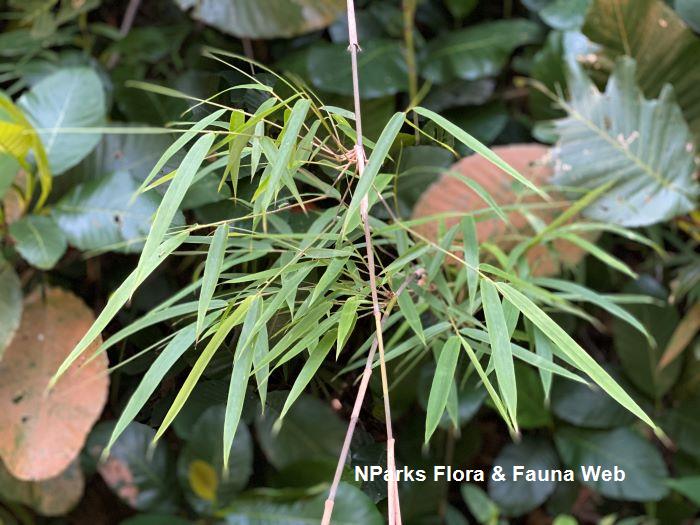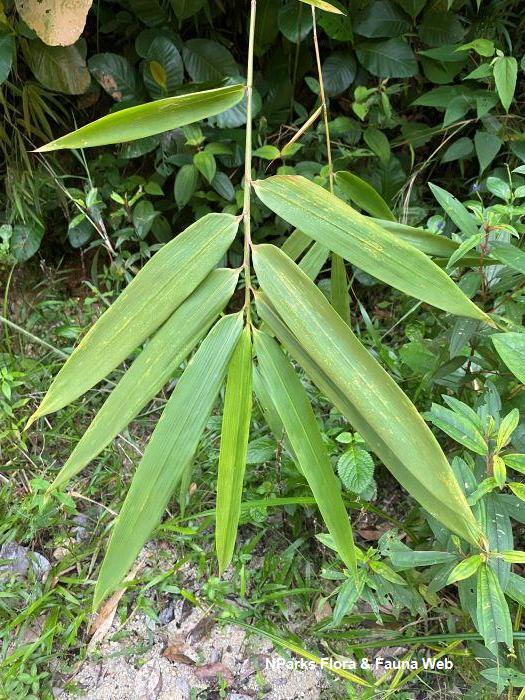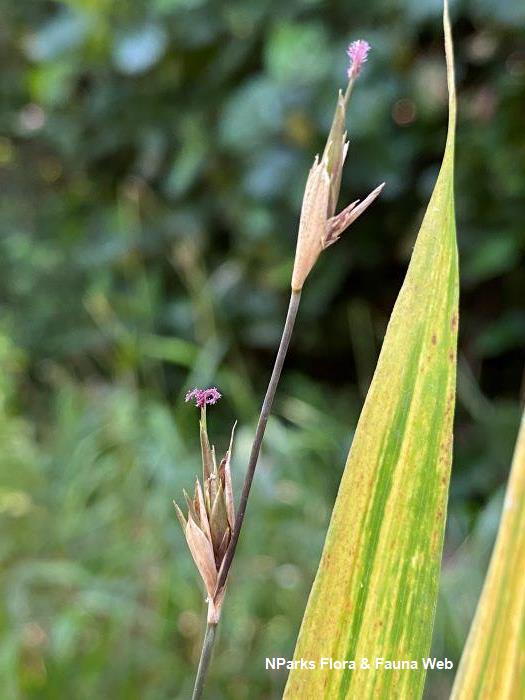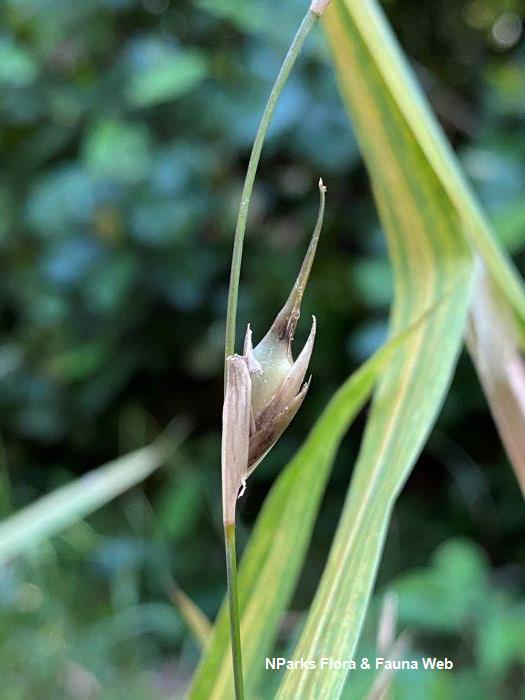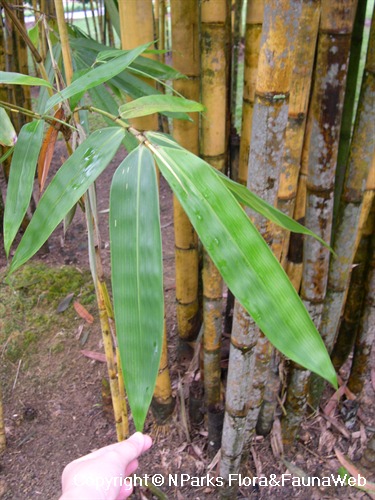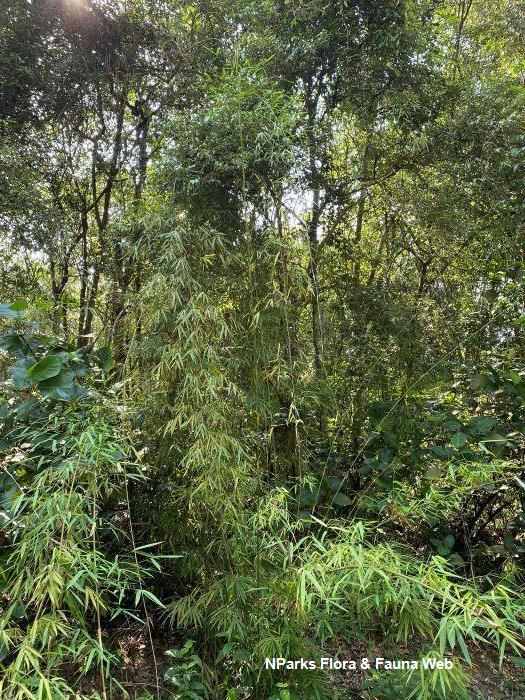
Name
Classifications and Characteristics
| Plant Division | Angiosperms (Flowering Seed Plants) (Monocotyledon) |
|---|---|
| Plant Growth Form | Bamboo |
| Lifespan (in Singapore) | Perennial |
| Mode of Nutrition | Autotrophic |
| Maximum Height | 6 m to 8 m |
Biogeography
| Native Distribution | Peninsular Malaysia, Singapore, and Sumatra |
|---|---|
| Native Habitat | Terrestrial (Freshwater Swamp Forest) |
| Preferred Climate Zone | Tropical |
| Local Conservation Status | Native to Singapore (Critically Endangered (CR)) |
Description and Ethnobotany
| Growth Form | It is a erect, clustering bamboo that can grow up to 8 m. Taller culms (aboveground stems of grasses and grass-like monocots) will tend to bend and arch over. |
|---|---|
| Foliage | The leaves are lance-shaped, growing up to 21 cm long and 2.7 cm wide. The surface of the leaves are covered in inconspicious, appressed hairs that point towards the tip while the underside is smooth. |
| Stems | The culms (aboveground stems of grasses and grass-like monocots) are erect, dark green, growing up to 1.5 cm wide, and covered in short white and pale brown hairs. Each node consists of a cluster of slender unequal branches, which holds 3 - 6 alternately-arranged leaves. |
| Flowers | The flowers are known as florets, and consists of heavily reduced petals and sepals, yellow anthers, and conspicuously wine-purple stigmas. The florets are clustered together, forming a spikelet, and arranged along the stem; this inflorescence is known as a pseudospikelet. |
| Fruit | The fruit is an ovoid caryopsis (a type of dry, indehiscent fruit, commonly known as a grain). |
| Habitat | It is found in moist or swampy ground and along waterbodies in lowland forests. |
| Taxonomy | This species was recently discovered at the Western Catchment in 2022, bringing the number of native bamboo species in Singapore to five. |
| Etymology | The generic epithet Schizostachyum is Greek for 'split spike', referring to the structure of the inflorescence. The specific epithet lengguanii is named in honour of Saw Leng Guan, a field botanist from the Forest Research Institute of Malaysia. |
Plant Care and Propagation
| Light Preference | Full Sun |
|---|---|
| Water Preference | Lots of Water, Moderate Water |
| Plant Growth Rate | Moderate |
| Propagation Method | Division, Seed |
Foliar
| Foliage Retention | Evergreen |
|---|---|
| Mature Foliage Colour(s) | Green |
| Mature Foliage Texture(s) | Hairy / Hirsute, Smooth, Thin |
| Foliar Type | Simple / Unifoliate |
| Foliar Arrangement Along Stem | Alternate |
| Foliar Attachment to Stem | Petiolate |
| Foliar Shape(s) | Non-Palm Foliage (Lanceolate) |
| Foliar Venation | Parallel |
| Foliar Apex - Tip | Acuminate |
| Foliar Base | Rounded / Obtuse |
| Typical Foliar Area | Mesophyll ( 45cm2 - 182.25 cm2 ) |
| Leaf Area Index (LAI) for Green Plot Ratio | 3.5 (Shrub & Groundcover - Monocot) |
Non - Foliar and Storage
| Stem Type & Modification | Culm |
|---|---|
| Root Type | Underground (Fibrous Root) |
Floral (Angiosperm)
| Flower & Plant Sexuality | Bisexual Flowers , Bisexual Flowers |
| Flower Colour(s) | Green, Purple |
|---|
| Flower Grouping | Cluster / Inflorescence |
| Flower Location | Axillary |
| Inflorescence Type | Spikelet / Pseudospikelet / Compound Spike |
| Flowering Period | A Few Times Yearly |
Fruit, Seed and Spore
| Mature Fruit Colour(s) | Brown, Green |
|---|---|
| Mature Fruit Texture(s) | Glossy / Shiny |
| Fruit Classification | Simple Fruit |
| Fruit Type | |
| Seed Quantity Per Fruit | Few (1-5) |
References
| References | Ng XY, Lua HK, Ooi ZY & Ang WF (2022) Schizostachyum lengguanii(Poaceae), a new native record and an updated key to the genus in Singapore. Nature in Singapore, Supplement 1: e2022117. DOI: 10.26107/NIS-2022-0117 |
|---|
Image Repository
Others
| Master ID | 30830 |
|---|---|
| Species ID | 5187 |
| Flora Disclaimer | The information in this website has been compiled from reliable sources, such as reference works on medicinal plants. It is not a substitute for medical advice or treatment and NParks does not purport to provide any medical advice. Readers should always consult his/her physician before using or consuming a plant for medicinal purposes. |

